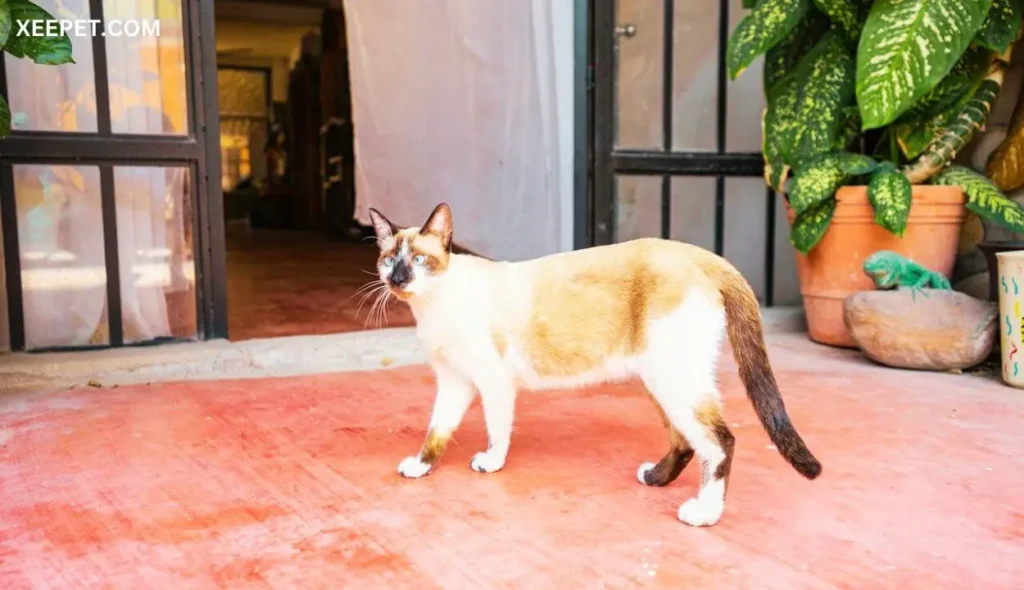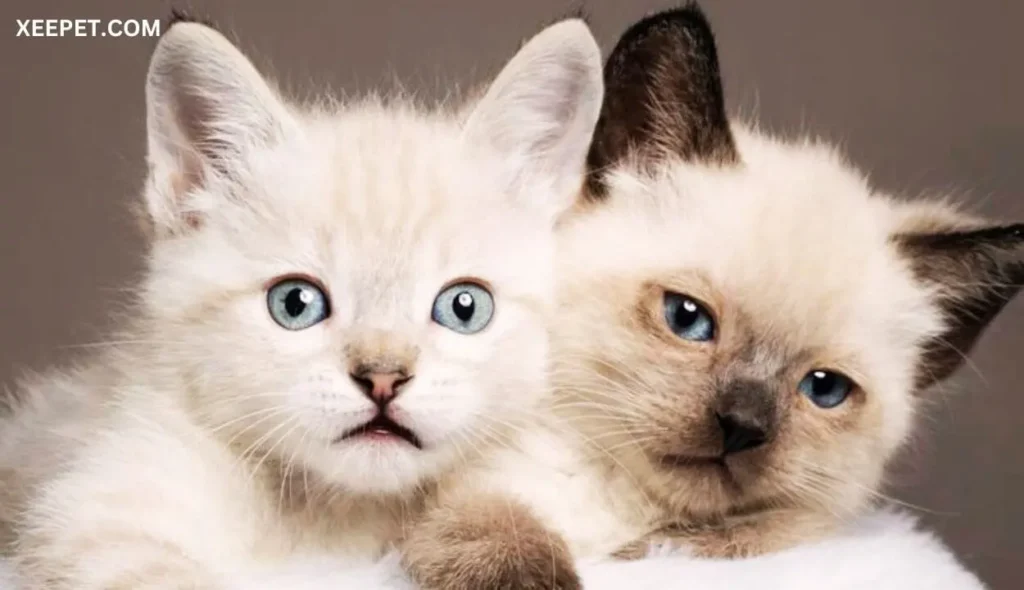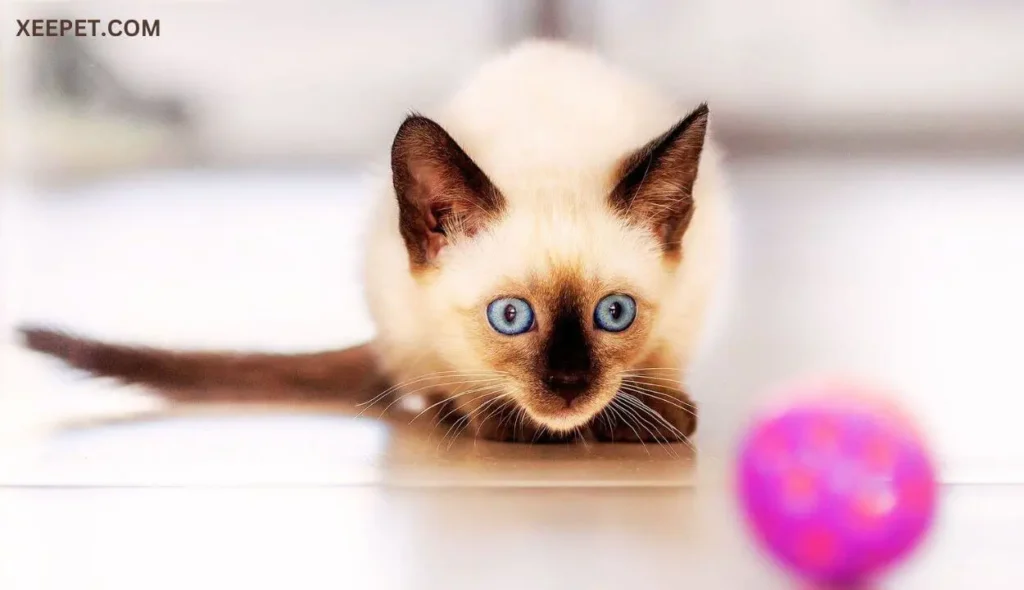Yes, Siamese cats do indeed get darker as they grow older. This interesting change in their coat’s color is due to a special mix of genetics and how their bodies react to temperature.
Siamese cats’ fur changes color when their body temperature changes. As they age, Siamese cats can’t hold onto heat as well as they did when they were younger. This makes them cooler, which in turn darkens their fur.
Also, as these cats get older, they might gain some weight. This can also lower their body temperature and make their fur darker.
If a Siamese cat lives in a cool climate, its fur can darken, especially during the colder months. But here’s a fun fact: their fur can lighten if they get too hot.
| Characteristic | Siamese Cat |
| Temperature | 101 – 102.5°F (38.3 – 39.2°C) |
| Lifespan | 12 – 20 years |
| Weight | 8 – 12 pounds (3.6 – 5.4 kg) |
| Size | Medium to large |
| Coat | Short, fine, and silky |
| Color Points | Seal, chocolate, blue, lilac, and more |
| Eye Color | Blue |
| Personality | Vocal, social, affectionate, intelligent |
| Activity Level | High |
| Grooming Needs | Moderate |
Understanding Siamese Cats’ Coloration
Siamese cats have a unique look that sets them apart, and it’s all thanks to something called temperature-sensitive albinism. This big term means their fur color changes based on the temperature. Their eyes, ears, face, paws, and tail – the coolest parts of their bodies – are darker.
On the other hand, the warmer parts of their bodies have lighter fur. Here’s an interesting fact: this gene that controls fur color reacts to heat. The gene makes less pigment when warm, so the fur is lighter.
This also explains why Siamese kittens are born entirely white. Inside the mother cat’s womb, it’s warm, so the kittens’ fur genes don’t make a lot of pigment. But as they grow and explore, different parts of their bodies cool down, and that’s when their darker points begin to show.
Age and Siamese Cats’ Color Changes
When Siamese kittens are born, they are all white. This is because of their unique form of albinism that responds to temperature changes. As they start to grow older, starting from two weeks, their color begins to change.
First, you will notice dark colors spreading on their legs and tails. By the time they reach one month, their final color shows up.
Interestingly, their coat’s color also reacts to the weather. Their fur tends to be lighter in hot areas, which turns darker in cold places. This color change is most visible on their “points, “ including their legs, tail, ears, or face.
As they age further, even their eye color changes. This change stands out because of their light-colored fur. So, the changing colors of a Siamese cat are not just for beauty. It’s a complex dance between their genes, age, and surroundings.
Other Factors That Influence Siamese Cats’ Color

Siamese cats are well-known for their unique color points. The darker colors on their ears, face, paws, and tails stand out against their lighter body color. Most people know that genes and temperature decide these color patterns. Yet, other less-known factors also play a big role.
Diet and Nutrition:
The food a cat eats can impact its overall health. This, in turn, can affect its coat color. For example, some nutrients help maintain the rich colors in a Siamese cat’s coat. The amino acid tyrosine is one of them. It’s important because it helps make melanin. This pigment gives color to a cat’s fur, skin, and eyes. If a cat doesn’t get enough tyrosine, its coat could become lighter.
Sunlight Can Change Things:
You might not believe it, but sunlight can also change the color of a Siamese cat’s coat. This is similar to how human hair becomes lighter when exposed to the sun for a long time.
The sun’s UV rays can break down the melanin in the cat’s fur. This can make the coat color lighter. But this change is usually temporary. The cat’s coat will return to its original color once it spends less time in the sun.
Age:
Siamese cats’ color points can become darker as they get older. This happens because older cats usually have a lower body temperature than younger ones. This produces more melanin in their cooler body parts (the points).
So, a Siamese cat that was cream and chocolate-colored as a kitten might grow into an adult with a nearly black face, ears, paws, and tail.
Influence of Migration:
Moving to new places also affects the color of Siamese cats. When these cats were taken to different parts of the world, people started to breed them selectively to bring out certain features, including color points. This has led to new color variations you might not see commonly in the cats’ original home.
Stress Changes Things:
Stress can also change a Siamese cat’s color. Just like long-term stress can make human hair grey, too much stress can affect a cat’s coat color. If a Siamese cat feels stressed for a long, its coat can become dull or even change color.
Plus, stress can lead to behaviors like grooming too much and changing how a cat’s coat looks and feels. A stressed cat might over-groom certain parts of its body, causing those areas to look lighter or darker.
Comparing Siamese Cats with Other Breeds

When you compare Siamese cats to other breeds, a few unique features make them stand out.
Let’s dive into these points and see what makes Siamese cats special.
Their Looks Are Hard to Miss:
First off, Siamese cats look different from most other breeds. They have short, sleek coats and almond-shaped blue eyes. But the real eye-catcher is the contrasting color points on their ears, faces, paws, and tails.
Now, if you look at other cat breeds, their bodies usually have a single color. Additionally, their eyes might be any color. For example, the British Shorthair has a thick coat and round gold eyes. The Maine Coon is large and has tufted ears with a coat that comes in many colors and patterns.
They Love to Talk and Socialize:
Siamese cats are also more talkative and social than other breeds. They have a unique, low-pitched voice they’re not shy about using! They love interacting and can get sad if left alone for too long.
In contrast, some breeds, like the Russian Blue or the Norwegian Forest Cat, are more laid back. They don’t need constant attention and are quite independent.
They are Smart and Love to Play:
Siamese cats are smart and playful. They enjoy playing with interactive toys, solving puzzle games, and even learning tricks. This makes them fun to live with but also challenging because they often find ways to get into unexpected places.
On the other hand, some breeds, like the Bengal cat , prefer a more relaxed lifestyle. They’d rather chill in a comfy spot than play around.
Tips for Caring for Siamese Cats as They Age

As your Siamese cat ages, you might notice their behavior and needs change. Here are some easy-to-follow tips to help you care for your aging friend.
Keep Up With Vet Visits:
It’s important to keep taking your Siamese cat to the vet regularly as they age. They can start to develop health issues like kidney disease, dental problems, diabetes, and arthritis. If you take them to the vet regularly, the vet can spot these issues early. Try to take your Siamese cat for a check-up at least twice a year.
Change Their Diet as Needed:
Siamese cats’ dietary needs can change as they get older. They might need to eat fewer calories to avoid gaining weight, but they still need a diet full of high-quality protein to keep their muscles strong. Some Siamese cats might even develop food allergies or sensitivities so they might need a special diet. Your vet can help you determine the best diet for your aging Siamese.
Keep Their Mind Active:
Siamese cats are really smart and curious. To keep their mind sharp as they age, give them puzzle toys, play interactive games with them, or teach them new tricks.
Help Them Exercise:
Even though your Siamese cat might not be as active as they used to be, it’s still important for them to exercise regularly. Gentle exercise can help manage their weight and keep their joints flexible. You could play with them using a toy mouse or laser pointer for a short time each day.
Make Their Environment Comfortable:
Older cats usually like quiet and comfortable environments. Ensure your Siamese cat has a cozy bed and can easily reach their food, water, and litter box. If your house has multiple floors, you should put these resources on each floor if they have trouble moving around.
Conclusion
It’s indeed true that Siamese cats get darker as they age. This isn’t just a random fact but a cool mix of their genes and body temperature.
As these cats age, their bodies make more melanin because of lower body temperatures. This extra melanin is what gives their fur a darker shade.
But remember, each Siamese cat is a unique little creature, so the color change can vary from cat to cat.
In the end, this fascinating trait makes Siamese cats even more special and loved all around the world.
FAQs
What age do Siamese cats change color?
Siamese cats begin to change color at about two weeks old, with their final color typically emerging by about a month old. However, their unique coat colors can fully develop between 12 and 18 months of age. Their fur also darkens as they age, especially in cooler climates or seasons. It’s important to note that Siamese kittens are born mostly white or light cream.
Do all Siamese cats turn dark?
Yes, all Siamese cats do tend to darken as they age. This is due to a genetic mutation known as the Himalayan gene, which makes their fur sensitive to temperature. Their fur darkens if their body temperature drops below their standard body temperature (around 101 – 102°F). This is why Siamese cats living in cooler climates may have darker fur. Also, a deficiency of an enzyme called tyrosine, responsible for melanin production, can cause their coat to turn a rusty brown. However, it’s important to note that the darkness of a Siamese cat’s fur can vary based on these factors, and not all Siamese cats will become very dark.
Do Siamese cats change color with the temperature?
Yes, Siamese cats do change color with temperature. This breed is known as temperature-sensitive albinos. Their genetics and ambient temperature influence their coat color. The cooler parts of their bodies tend to become darker, while warmer parts remain light. This is why Siamese kittens are born white; their color changes as they mature and are exposed to different temperatures. It’s also common for a Siamese cat’s fur to become darker as it ages, especially in cooler regions.
When do Siamese cats stop changing color?
Siamese cats typically stop changing color by the end of their first year, with full development of their unique coat colors occurring between 12 and 18 months of age. Their color transformation is influenced by temperature and environment, with their coats getting darker when it gets colder. However, their color may change slightly yearly as new coats grow out.




![Read more about the article Bengal Cat Colors [A Study Of Their Unique Colors]](https://xeepet.com/wp-content/uploads/2023/11/Bengal-Cats-Color-300x173.webp)